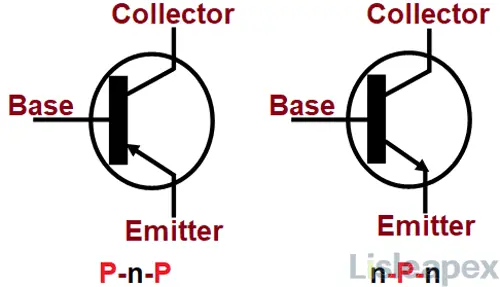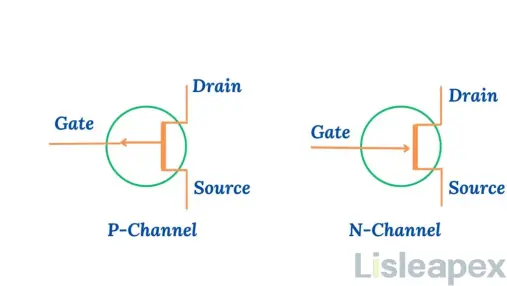Previous: BCM59111KMLG Broadcom POE Datasheet
Transistors are fundamental components in the realm of electronics, serving vital roles in amplification, signal processing, and switching within modern technology. Bipolar Junction Transistors (BJTs) and Field-Effect Transistors (FETs) stand out as two commonly used transistor types, each with distinct characteristics.
Understanding the differences between BJT and FET is essential for engineers and enthusiasts alike, aiding in selecting the appropriate transistor for specific applications. In this article, we will explore the dissimilarities between these two fundamental transistor types, examining their unique features, working principles, and advantages.
What is BJT
A Bipolar Junction Transistor (BJT) is a semiconductor device comprising three terminals: the base, collector, and emitter. It is constructed with two pn junctions, allowing it to amplify or control signals. Operating as a current-controlled device, a small input signal applied to the base can result in a larger amplified signal at the collector.

BJT transistors are available in two types: PNP and NPN. In an NPN transistor, current flows from the emitter to the collector, controlled by the base current. Conversely, in a PNP transistor, current flows from the emitter to the base, regulated by the base current. BJTs find widespread use in electronic applications, functioning as amplifiers, switches, oscillators, and in various logic and signal processing circuits. Their versatility and reliability make them integral components in devices such as mobile phones, televisions, radio transmitters, and industrial control systems.
What is FET
A Field-Effect Transistor (FET) is a crucial semiconductor device used in electronic circuits for amplification, switching, and signal processing. It comprises a channel made of semiconductor material, with electrodes known as the source and the drain connected at either end. A third electrode, termed the gate, is positioned close to the channel, enabling control over the flow of current between the source and the drain terminals. By applying a voltage to the gate terminal, the conductivity of the channel can be modulated, thereby regulating the current flow between the source and the drain.

FETs are classified into two main types based on their mode of operation: enhancement mode and depletion mode. In enhancement mode FETs, the voltage applied at the gate increases the current flow through the channel, whereas in depletion mode FETs, it decreases the current flow.
Operationally, when a voltage is applied to the gate electrode, it creates an electric field across the insulating layer, resulting in the formation of a depletion region in the channel. This depletion region reduces the number of free charge carriers in the channel, thereby reducing its conductivity. Consequently, by varying the voltage at the gate terminal, the conductivity of the channel can be controlled, and thus the flow of current through the FET can be modulated.
FETs find widespread application in various electronic devices and systems due to their versatility and efficiency. They are utilized in applications such as low-frequency amplifiers, radio frequency amplifiers, operational amplifiers, mixer circuits, memory modules, and large-scale integration (LSI) circuits. The unique properties of FETs, including voltage-controlled operation and high input impedance, make them indispensable components in modern electronic circuits and technology.
Difference between BJT and FET
Bipolar Junction Transistor (BJT) and Field-Effect Transistor (FET) are two fundamental types of transistors with distinctive characteristics and operating principles. Understanding their differences is crucial for selecting the appropriate transistor type for specific electronic applications.
|
Parameter |
BJT |
FET |
|
Full form |
Bipolar Junction Transistor |
Field Effect Transistor |
|
Definition |
Uses both majority and minority charge carriers for conduction |
Utilizes only majority charge carriers for conduction |
|
Drive type |
Current-controlled device |
Voltage-controlled device |
|
Terminals |
Emitter, Base, and Collector |
Source, Drain, and Gate |
|
PN junction |
Consists of two PN junctions: emitter-base junction and collector-base junction |
Does not have PN junctions |
|
Control element |
BJT is controlled by the amount of current flowing into its base terminal |
FET is controlled by the voltage applied to its gate terminal |
|
Types |
NPN transistor and PNP transistor |
N-channel FET and P-channel FET |
|
Configuration |
Common emitter (CE), common base (CB), and common collector (CC) |
Common source (CS), common gate (CG), and common drain (CD) |
|
Size |
Larger in size and requires more space |
Smaller in size and easier to fabricate as an IC |
|
Sensitivity |
More sensitive to changes in applied voltage |
Less sensitive to variations in applied voltage |
|
Relationship |
Linear relationship between input and output |
Non-linear relationship between input and output |
|
Thermal noise |
More thermal noise |
Lower thermal noise |
|
Thermal stability |
Less thermal stability |
Good thermal stability |
|
Input impedance |
Low input impedance due to forward bias of input circuit |
High input impedance due to reverse bias of input circuit |
|
Temperature coefficient |
Positive temperature coefficient |
Negative temperature coefficient |
|
Suitability |
Suitable for low current applications |
Suitable for high current applications |
|
Switching speed |
Lower switching speed |
Higher switching speed |
|
Effect of radiation |
Susceptible to radiation |
Relatively immune to radiation |
|
Gain bandwidth product |
Higher gain bandwidth product |
Lower gain bandwidth product |
|
Minority carrier storage effect |
Suffers from minority carrier storage effect |
Does not suffer from minority carrier storage effect |
|
Cost |
Cheaper to manufacture |
Relatively expensive to manufacture |
|
Installation |
Does not require special handling during installation |
Demands special handling during installation |
|
Applications |
Used as a switch (in saturation and cut-off region) and amplifier (in active region) |
Used as a switch (in Ohmic and cut-off region) and as an amplifier (in saturation region) |
In summary, BJT and FET differ in terms of their mode of operation, terminal configuration, types, size, sensitivity, relationship between input and output, thermal noise, thermal stability, input impedance, temperature coefficient, suitability, switching speed, effect of radiation, gain bandwidth product, minority carrier storage effect, cost, installation requirements, and applications. The choice between BJT and FET depends on the specific requirements of the application, such as current level, voltage control, switching speed, noise sensitivity, and radiation immunity.
Advantages and Disadvantages: Difference between BJT and FET
Advantages of BJT:
- High Current Gain: BJT offers high current amplification capabilities.
- Wide Power Device Application: BJT can operate effectively across a range of power levels.
- Large Gain Bandwidth: BJT exhibits a wide bandwidth for signal amplification.
- High Performance in High Frequencies: BJT performs well at high frequencies, making it suitable for various applications.
- Low Forward Voltage and Better Voltage Gain: BJT typically has a lower forward voltage drop and higher voltage gain.
Disadvantages of BJT:
- Large Chip Area Requirement: BJT fabrication requires a significant chip area.
- High Power Loss: BJT devices suffer from relatively high power losses.
- Temperature Sensitivity: BJT performance is highly sensitive to temperature variations.
- High Noise Levels: BJT circuits may generate significant levels of noise.
- Radiation Sensitivity: BJT devices are more susceptible to radiation effects.
Advantages of FET:
- High Input Impedance: FETs offer high input impedance, minimizing loading effects in circuits.
- Low Noise Production: FETs typically produce less noise compared to BJTs.
- Radiation Insensitivity: FETs are less sensitive to radiation, making them suitable for certain applications in harsh environments.
- Wide Operating Frequency Range: FETs can operate effectively across a wide range of frequencies.
- Compact Fabrication: FETs can be fabricated in a relatively smaller chip area.
Disadvantages of FET:
- Cost: FETs can be more expensive compared to BJTs.
- Low Transconductance: FETs may exhibit lower transconductance compared to BJTs.
- Limited High-Frequency Performance: FETs may not perform as well at very high frequencies.
- Small Gain Bandwidth: FETs typically have a smaller gain bandwidth compared to BJTs.
Advantages of FET Over BJT?
FETs have several key advantages over their BJT counterparts that stem from their unique design and operation. Firstly, FETs boast a superior noise margin compared to BJTs, which enhances signal fidelity and reduces signal degradation in electronic circuits, ensuring clearer and more reliable performance.
Moreover, FETs operate with lower power consumption since they control current flow without drawing current from the control terminal. This not only enhances energy efficiency but also helps in reducing heat generation, which is crucial for various electronic applications where power conservation is paramount.
In terms of physical size and structure, FETs offer a more compact packaging density due to their smaller size and simpler construction compared to BJTs. This characteristic makes FETs particularly suitable for implementing storage devices and integrated circuits, where space efficiency is critical for achieving optimal performance and functionality.
Furthermore, FETs experience fewer scaling issues compared to BJTs, making them more adaptable to the ongoing miniaturization trends in semiconductor technology. This scalability factor contributes significantly to the development of compact and high-performance electronic devices that meet the demands of modern technology.
Lastly, FETs excel in ultra-fast circuits, especially with advancements such as Heterojunction BJTs, making them the preferred choice for applications requiring high power efficiency and rapid signal processing. This versatility positions FETs as indispensable components in various electronic systems, particularly those demanding high-speed data transmission and processing capabilities.
Application: Choosing between BJT and FET
When considering the selection between BJT (Bipolar Junction Transistor) and FET (Field-Effect Transistor) for various applications, understanding their distinct characteristics and performance attributes is crucial. Here's a professional overview of the applications where each transistor type excels:
BJT Applications
Amplification: BJTs are commonly employed as amplifiers in audio circuits, radio frequency (RF) circuits, and other electronic systems where signal amplification is required.
Oscillation: BJTs are utilized in oscillator circuits for generating periodic signals, making them essential components in clock circuits, signal generators, and communication systems.
Switching: Due to their ability to control current flow, BJTs find applications in electronic switching circuits, such as relay drivers, motor control circuits, and power supply regulators.
Multivibrators: BJTs are integral to multivibrator circuits, which produce square, triangular, or sawtooth waveforms, utilized in applications like pulse generation, timing circuits, and frequency synthesis.
Timer and Delay Circuits: BJTs are employed in timer and time-delay circuits for precise control of timing functions, utilized in applications ranging from industrial automation to consumer electronics.
FET Applications
Frequency Amplification: FETs are extensively used in FM devices for amplifying frequency signals, making them essential components in radio communication systems, radar systems, and wireless devices.
Memory Devices: FETs are integral to memory chips, including static random-access memory (SRAM) and dynamic random-access memory (DRAM), facilitating data storage and retrieval in digital electronic systems.
Variable Voltage Resistors: FETs are utilized as variable voltage resistors in operational amplifier circuits, providing precise control over voltage levels in analog signal processing applications, instrumentation, and control systems.
Mixer Operation: FETs play a crucial role in TV and FM receivers for mixer operation, where they combine multiple input signals to produce an output signal at a different frequency, essential for frequency conversion and demodulation.
Mixer Circuit Construction: FETs are employed in constructing mixer circuits for frequency conversion and modulation-demodulation operations in communication systems, radar systems, and electronic instrumentation.
In summary, while BJTs excel in applications requiring signal amplification, oscillation, switching, and timing functions, FETs are preferred for frequency amplification, memory storage, voltage control, mixer operation, and frequency conversion tasks. The selection between BJT and FET ultimately depends on the specific requirements of the application, considering factors such as signal characteristics, power consumption, and circuit complexity.
Conclusion
In summary, the Bipolar Junction Transistor (BJT) and the Field-Effect Transistor (FET) are two distinct types of transistors, each offering unique characteristics and advantages. While the BJT excels in applications requiring high current amplification and low-frequency operation due to its current-controlled behavior and low input impedance, the FET stands out for its voltage-controlled behavior, high input impedance, low power consumption, and fast switching speeds, making it ideal for high-frequency applications, low-power circuits, and digital signal processing.
The selection between BJT and FET depends on the specific requirements of the application, including factors such as current handling capabilities, voltage gain, power consumption, and cost-effectiveness. By understanding the disparities between BJT and FET, engineers can make informed decisions to optimize the performance of their electronic designs, thereby contributing to advancements in various technological fields.
FAQ
-
Are BJT and FET interchangeable in all applications?
No, BJT and FET have different characteristics and operating principles, so they are not always interchangeable. The choice between them depends on the specific requirements of the application, such as voltage, current, frequency, and temperature range.
-
What are the main advantages of FET over BJT?
FET has higher input impedance, making it less loading on the input signal source. It has better thermal stability and is less affected by temperature variations. FET typically has simpler drive circuitry and consumes less power in certain applications.
-
What are the main advantages of BJT over FET?
BJT generally has lower input capacitance, making it suitable for high-frequency applications. It exhibits better linearity and lower noise performance in certain operating conditions.
-
Which one has higher switching speed: BJT or FET?
FET generally has a higher switching speed than BJT due to its simpler construction and lower input capacitance.
-
Which one has higher input impedance: BJT or FET?
FET typically has a higher input impedance compared to BJT, making it suitable for high-impedance input applications.
-
What are the operating principles of BJT and FET?
BJT operates by controlling the flow of charge carriers (electrons and holes) between its layers using current at the base terminal. FET operates by modulating the conductivity of a semiconductor channel using an electric field applied to the gate terminal.
-
How do BJT and FET differ in construction?
BJT consists of three semiconductor layers: the emitter, base, and collector, with two types: NPN and PNP. FET comprises a semiconductor channel controlled by an electric field, with three main types: MOSFET (Metal-Oxide-Semiconductor FET), JFET (Junction FET), and MESFET (Metal-Semiconductor FET).
Stay updated with Lisleapex by signing up for the newsletter


 Congratulations On Your Successful Submission
Congratulations On Your Successful Submission
 Submission Failure
Submission Failure